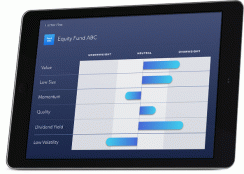Investors have long been familiar with the Style Box – a 3 x 3 grid that divides funds into nine boxes using value and size factors. It was introduced by Morningstar in 1992. Since then, the understanding of the underlying drivers of return – factors – has evolved to recognize that more factors than just value and size have been historically associated with long-run excess returns. That’s why, in partnership with MSCI, BlackRock is introducing the Factor Box, a wider lens through which to view equity style factors including value, size, momentum, quality, yield, and low volatility.
Style factors, which are the focus of the Factor Box, explain returns within asset classes. Academics and practitioners have long found that cheap stocks (value), stocks that are trending (momentum) and stocks with higher quality earnings (quality) – to name a few factors – tend to outperform the market over the long run. We observe the same style factors in fixed income, commodities, foreign exchange and other asset classes. (The second main type of factors – macro – drive returns across asset classes.)
“Just as color and other technological developments revolutionized the experience we have watching movies, the lens offered by the Factor Box can dramatically change how we construct and manage a portfolio of investments by offering a more complete picture of the underlying factors that affect a portfolios investment performance,” says Andrew Ang, Managing Director, Head of Factor-Based Strategies at BlackRock.
“When you experience this new lens that combines advances in data and technology with fundamental investment ideas, it will be like moving from watching a movie on a black and white TV, to moving to color – it will be transformative,” says Ang.
The Factor Box shows exposures across six factors
The Factor Box compliments the Style Box concept, incorporating a more complete view of the dominant drivers of returns within equity markets. The Factor Box pushes from two factors to a full color array of factors. “Value, quality, momentum, size and low volatility have historically beat the market on a risk-adjusted basis and have strong economic intuition. The Factor Box also adds yield — a measurement of high and persistent dividend yields — because income considerations are important for many investors, especially for those in retirement,” says Ang.

The Factor Box displays the relative factor exposure of a stock or a group of stocks versus a comparative universe, such as the broad market. Factor exposures may change over time. For illustrative purposes only. The Factor Box should not be interpreted as a recommendation of any security or investment strategy.
Click here to register for Factors: A New Lens virtual conference on May 1
Using the Factor Box
The Factor Box can be used in a similar way to the Style Box, but with more depth and richness. For example, it can help to…
- Assess portfolio diversification. Do you have all, not just two, factors? If a portfolio lacks exposure to quality, for example, and has too much momentum, appropriate action can be taken.
- Evaluate fund exposures. Perhaps the factor exposures in a traditional actively managed fund can be obtained in a more efficient way with lower-cost, fully transparent, smart beta ETFs. The Factor Box can help find the most appropriate smart beta factor exposure. “Seeing exposures alone is not enough, of course,” says Mark Carver, Head of Factor Index Products, MSCI. “You want to understand the way those portfolios, and the way portfolios generally, are constructed.”
- Conduct due diligence. The Factor Box can analyze factor exposures for each security. This provides a transparent view of a fund’s actual exposures based on underlying holdings, not just the exposures the managers claim to be targeting. This can help when choosing between funds to fill an allocation. “When investors build portfolios, we find they’re often allocating across factor strategies, cap-weighted index funds, and active managers,” says Carver. “In the factor realm, an effective due diligence process is needed. Investors may first ask: What factors are included in that manager or this group of managers that I'm evaluating? Are those factors consistent with the goals of the portfolios? Is the strategy a single factor such as value, or is it multiple factors: value, momentum, quality, size, et cetera?”
- Tilt dynamically. The snapshot provided by the Factor Box could help investors position factor exposures through the business cycle. Tactical investors who believe the economy is signaling for value to outperform, for example, could use the exposure insights of the Factor Box to reallocate within their existing holdings to implement a short-term tilt.
The optimal factor mix will differ across investors, but here are some “off-the-shelf” options you could consider:
Balanced macro factor exposure. A simple, but robust, benchmark would hold equal weights in the six macro factors to ensure the portfolio has maximum diversification. But, some investors may want larger weights in some factors in line with their preferences. For example, an investor concerned about drawdowns may allocate more to defensive factors, such as real rates and inflation.
Style factor exposure. Style factors such as value, momentum, quality and size can enhance returns relative to a market-capitalization benchmark. For the more risk-averse investor, minimum volatility strategies can help reduce the drawdowns of equities while maintaining long-term return potential.
Macro and style factors. Macro factors can be combined at the whole portfolio with targeted style factors within certain asset classes. Because returns from style factors can be uncorrelated with macro factors, if implemented in a long-short approach, holding both macro and style factors can be highly diversifying.
Click here to register for Factors: A New Lens virtual conference on May 1






